
Earlier this year BHP admitted to institutional investors it “overinvested” in its Jansen potash project in Saskatchewan, where the Anglo-Australian giant has already spent nearly $3 billion over six years.
BHP’s commodity outlook accompanying its bumper annual results released on Monday seems to indicate the world’s largest mining company will continue to be cautious about advancing the project.
The global potash market of around 65m tonnes per year has rallied since mid-2016, boosted in part by idled capacity in North America and robust demand from Brazil and China.
The global potash market of around 65m tonnes per year has rallied since mid-2016
But BHP now sees slowing momentum for the crop nutrient, with demand growing by an uninspiring 2–3%, or 1.5–2m tonnes a year through the 2020s despite supportive global trends of a rising population, changing diets and the need for “sustainable intensification of agriculture.”
BHP is spending a higher than expected $8 billion on capital projects this year, but in an analysts debriefing, Peter Beaven, BHP CFO, said there will be “a relatively small spend in the scheme of things, on Jansen.” CEO Andrew Mackenzie added that Jansen is a project “that’s relatively backend loaded in terms of costs, which gives us some of the flexibility.”
That “flexibility” on capex could extend more than a decade into the future, according to BHP’s outlook for potash:
Our low case for potash is predicated on all presently latent capacity returning to the market at disruptive speed; considerable brownfield and greenfield additions coming to market; a low case macro environment curbing both opex and capex costs; ‘cheap’ currencies in major producer jurisdictions; a five percentage lift in crop residue recycling; minimal dietary change and crop mix; and a similar end–state for soil K mining to what is observed today. All of which serves to delay market balance and the onset of inducement pricing to well beyond the 2020s.
BHP Economic and Commodity Outlook – 20 August 2019
Two shafts have been sunk at Jansen, but BHP will have to invest another $5.3–$5.7 billion to finish phase one construction of the mine, which the company said would take fewer than 5 years to complete. BHP has in the past said it would consider selling a stake in Jansen to share capital and risk.
BHP says it can produce potash for around $100 a tonne at the mine. In July benchmark pricing at the port of Vancouver was up 14% year on year to $266 a tonne (mid-point FOB standard grade). That compares to around $400 a tonne when Jansen was first conceived and record highs more than a decade ago of $870 per tonne.
The deposit can accommodate another three phases – at $4 billion per phase – that would lift annual capacity to more than 16 million tonnes per year, vastly improving the economics of the project.
BHP has long been eager to enter the potash market in Saskatchewan, diversifying its asset base now concentrated around iron ore and copper since disposing of its US oil assets a year ago.
In 2010, Canada blocked BHP’s $40 billion hostile takeover bid for Potash Corp (now Nutrien after a merger with Agrium) arguing the company’s mines are strategic national assets.